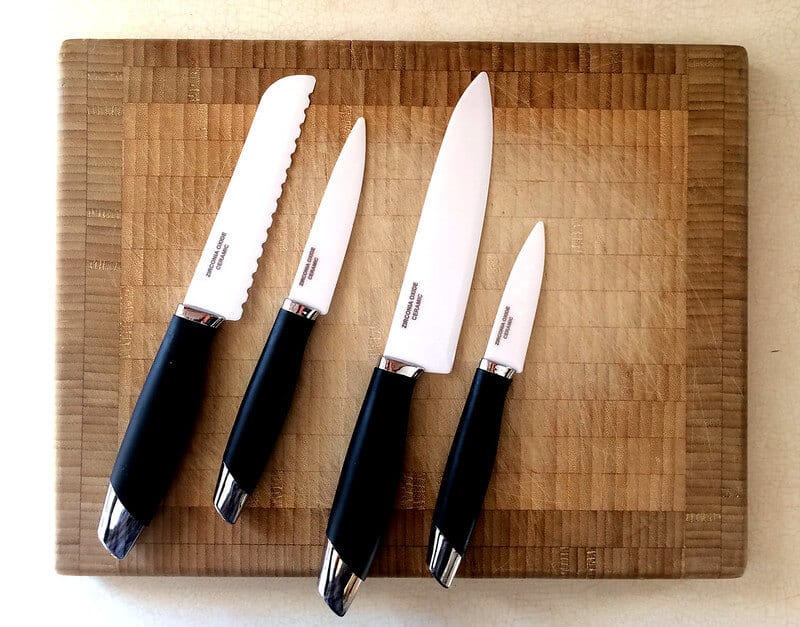Ceramic knives have slowly grown into a popular kitchen utensil. These knives are now found in almost all homes. Everyone wants their knives sharp, but many people think that ceramic knives never go dull. But the truth is that while they stay sharp for a longer period, the ceramic kitchen knives eventually become dull. How soon a ceramic knife will become dull depends on how frequently it is used.
When the knife becomes dull, you might look for ways to make it sharp again. Yes, you can have your ceramic knives sharpened by a professional to get the best outcomes. But remember that it can be very costly and not feasible for everyone. So, it makes sense to sharpen ceramic knives at home. It can save you money and time that you may otherwise spend to sharpen ceramic knives by going to a knife sharpening professional.
In this post, we’ll tell you how to sharpen ceramic knives at home. But first, let’s discuss some of the basics of ceramic kitchen knives.
Basics of Ceramic Knives and Their Perks

Ceramic knives are created from a material known as zirconium dioxide or zirconia. This differentiates them from the average ceramics you might be accustomed to, such as mugs, plates, and vases.
Zirconia gives ceramic knives their hardness and helps the blade remain sharper for a longer period compared to conventional stainless steel knives used otherwise. These knives also weigh considerably less than stainless steel knives (approximately half the weight), which allows the user to have a natural, more comfortable grip and use.
Drawbacks of Ceramic Knives
Despite their benefits, ceramic knives come with certain downsides. These include the following:
- Ceramic knives are made of a material that is brittle in nature, and any drops, twists, or significant impact bumps will lead to them breaking or chipping away.
- Ceramic knives need special care and must be placed in a separate box or container, away from other utensils in the household.
- The knives require precision experience and are often harder to sharpen than conventional steel knives despite their longevity in comparison to those knives.
- Ceramic knives cannot cut all types of foods, and using them to cut harder or frozen foods will likely lead to their blades chipping or breaking.
How to Sharpen Ceramic Knives
Many ceramic knife manufacturers advertise these knives as something that does not need sharpening. With all the talk about them being sharp for longer than regular knives, one can be forgiven for believing in this. However, this could not be further from the truth. Despite the longevity of their blades, ceramic knives will eventually dull out and need to be sharpened.
If you don’t afford professional knife sharpening or want to try sharpening your knife at home for your convenience, you might be wondering how to sharpen a ceramic knife. The good news is that we’ve some great ideas for you to sharpen ceramic knives. With the right sharpeners, you can quickly implement these ideas to sharpen your ceramic knives at home.
Use our step-by-step guide to sharpen ceramic knives from the comfort of your home.
Things You’ll Need for Sharpening a Ceramic Knife
There are several ways to sharpen ceramic knives. The most common and effective method is by using a diamond-coated sharpening stone. These diamond stones come in a variety of coarseness levels, which are known as grit levels. The grit levels range from 200 grit and going all the way up to 1500 grit.
A lower grinding level defines a coarser surface level and will remove a greater quantity of the blade, whereas a higher grinding level is used to polish the blade and construct a much sharper edge on the knife. The level you choose will vary depending on the dullness of your ceramic knife.
For knives that are damaged and have had pieces chipped off, a lower grit stone will come in handy to help with removing the majority of the knife blade. After this, using its higher counterpart on the knife, such as a 1,000 grit one, will help achieve a more refined, sharper edge on the knife.
The Sharpening Process
Now that you have gotten the diamond stone with your required grit level, it’s time to start sharpening a ceramic knife.
First off, place your diamond stone onto a flat surface. It is essential that the diamond stones don’t move too much while sharpening to prevent uneven or inaccurate edges on your ceramic knife.
At times holders are included with diamond crust to help keep them in place while sharpening. However, even if you do not possess a holder, you can set your diamond stone on a damp kitchen towel or cloth to fulfill the same requirement.
Next, you will need to assess the level of your ceramic knife’s blade and angle it 15-20 degrees to the diamond stone, depending on the brand of your knife. In order to measure this in the most accurate possible way, try to begin by angling the knife at a 90-degree angle from the diamond stone. Then, tilt the blade of the knife to half of that, following which you should tilt it one more time to arrive at an angle of approximately 20 degrees.
As ceramic knives are brittle and prone to having their blade chipped off with a greater force, it would be wise not to exert too much pressure on the sides of the knife. To avoid having your knife damaged midway through the sharpening process, it is important to push down on the knife gently. This can be done by holding the handle of the knife in one hand, and bracing the handle of the knife in the other hand, and then pushing lightly.
Start off by rubbing the tip of the knife blade against the diamond stone and making your way from there to the handle of the knife by gently gliding the blade from one end to the other. The strokes on both sides of the blade should be equal.
This exercise can take anywhere between 5 to 20 minutes, depending on how dull your knife is and the degree to which it needs to be sharpened.
Alternate Methods of Sharpening a Ceramic Knife
The material you are using to sharpen your ceramic knife needs to be sharper than the ceramic knife itself in order for the sharpening to be successful. At the moment, diamond is the only material capable enough to work as a sharpener for ceramic knives. However, this does not mean that you only have the option of using diamond stones if you want to sharpen your ceramic knife. There are many other knife sharpeners that you can use for the purposes, including the following:
Knife Sharpener
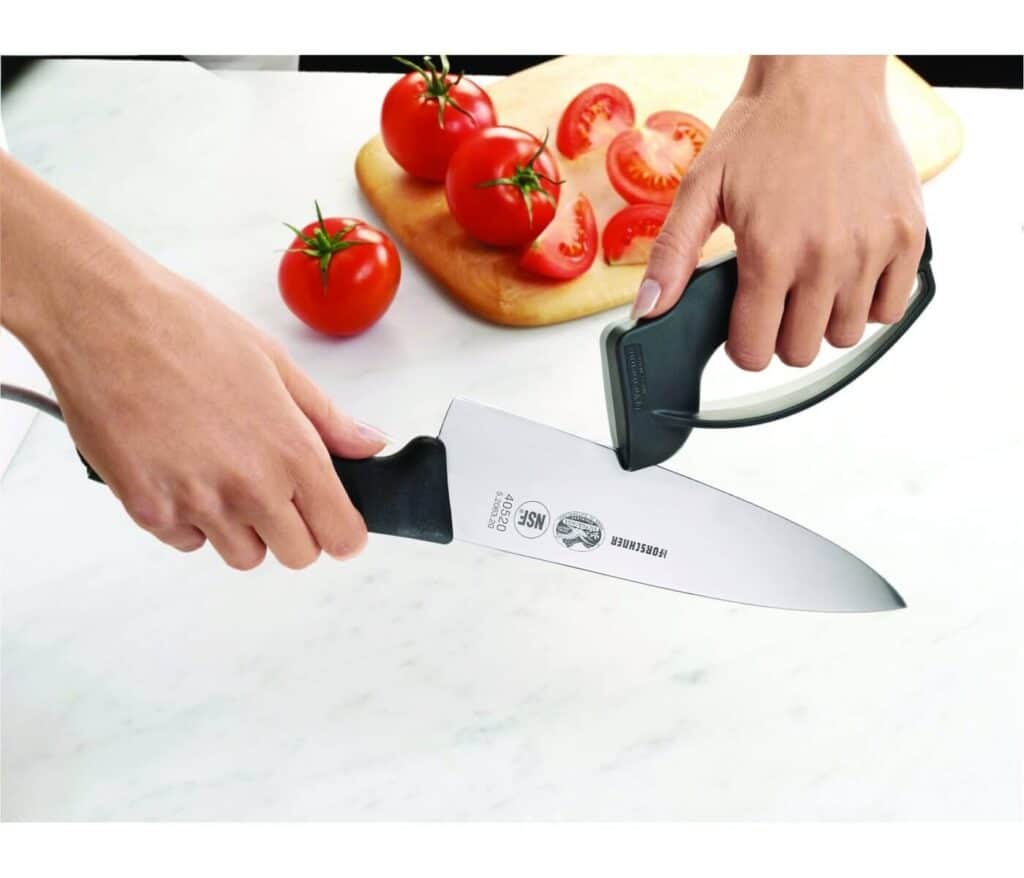
There are a bunch of knife sharpeners available in the market which are diamond-encrusted or can be equipped with diamond stones. These knife sharpeners would work on ceramic knives due to their diamond-encrusted surface, as well as conventional steel knives, so they would be a wise investment.
Electric Knife Sharpener
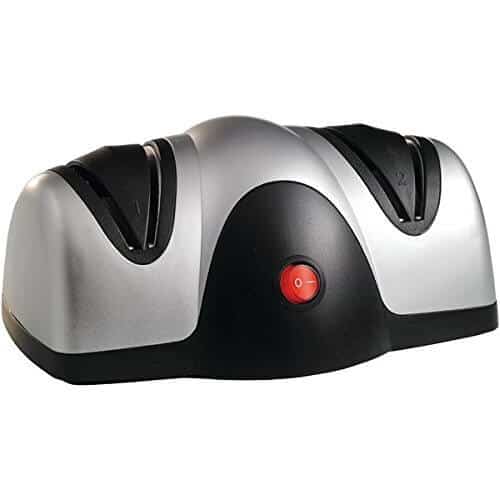
If equipped with some sort of abrasives that are sharper than ceramic, then an electric knife sharpener can also be used to sharpen your ceramic knives. Generally, the abrasive that meets this criterion comes in the form of a diamond abrasive. As such, you will need to ensure, before purchasing the electric sharpener, that it can handle sharpening ceramic knife blades.
Sharpening Stones
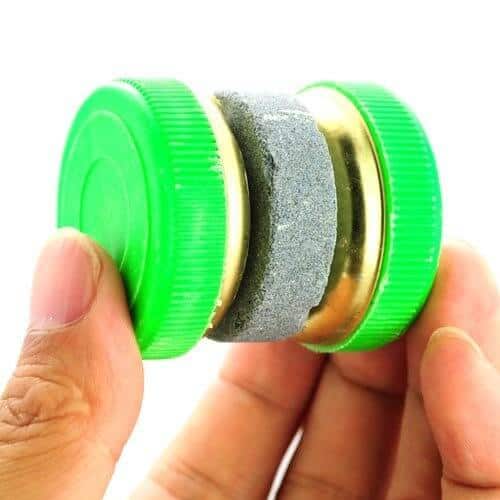
Though they will not achieve the exact same result as their diamond layered counterparts, sharpening stones can, to an extent, work on ceramic knives. Water stones, which are usually used to sharpen steel knives, can substitute if you are unable to acquire the diamond ones.
However, these should not be used as a constant source of sharpening ceramic knives. The reason for this is that the knives will not be sharper for as long a period as they would be if they were sharpened with a diamond stone.
Diamond Sharpening Rod
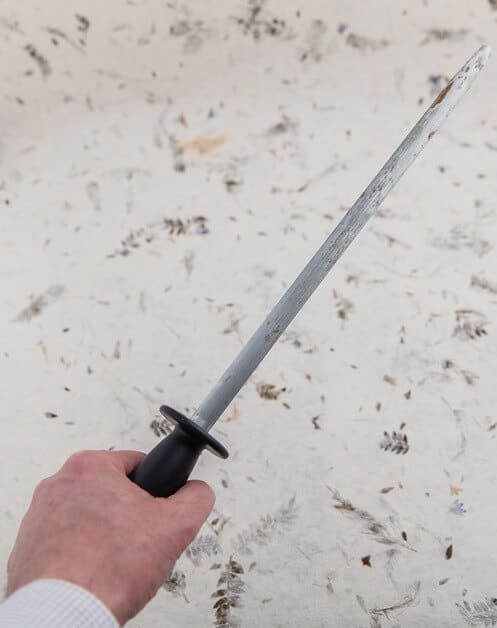
A diamond sharpening rod possesses a diamond-encrusted surface, measures approximately 12 inches, and has a handle on one end. These rods work productively towards removing layers from the knife.
The positive about these rods is that they can be used on a ceramic blade and on a conventional stainless steel knife as well. However, they must be used with caution as if they are not operated in the proper manner, they can chip off parts of the blade. They require an extra degree of precision to function, and should you not be able to achieve this, it might be more suitable for you to use diamond stones.
Diamond Pull-Through Knife Sharpener
A diamond pull-through knife sharpener is a sharpening tool that is likely to work more effectively in comparison to a sharpening rod as they reduce the chances of damages. This tool comprises two diamond-encrusted surfaces that simultaneously traverse at the same angle as the knife. This results in the development of a sharp edge for both sides of the knife at the same time.
You can choose either a manual or electric sharpener, depending on your needs. Before purchasing one, ensure that the pull-through sharpener is diamond-encrusted. If it isn’t, then your attempts to sharpen your ceramic blade through this method will prove to be futile.
How to Maintain a Ceramic Knife Properly
In order to save yourself from the hassle of having to sharpen and go through ceramic knives at a rapid rate, there are some measures that you can undertake to increase the usage period of these knives:
Treat Ceramic Knives With Care
Ceramic knives, though sharp, are brittle in nature. This means that they are more susceptible to chipping and breaking off easier than stainless steel knives would be. Dropping ceramic knives can damage the blade severely, and for this reason, it is vital to handle all ceramic knives with utmost care.
Store Ceramic Knives Separately
You should store your ceramic knives in a separate box or container rather than putting them alongside all the other utensils in your house. This needs to be done as if ceramic knives are placed in the same drawer as these utensils, the opening, and closing of the drawer will cause the knives to strike other items, which can result in their blades chipping off or being damaged. It is, thus, recommended to place ceramic knives in an environment where they will not be at risk of damage from constant movement.
Wash Ceramic Knives Only By Hand
Using a dishwasher to wash and clean your ceramic knives will also leave them prone to damage for the same reasons as putting them in drawers: collisions with other utensils will chip off the blade or break it. Thus, ceramic knives should only ever be washed by hand and be kept far away from dishwashers.
Be Wary of What You Cut with Ceramic Knives
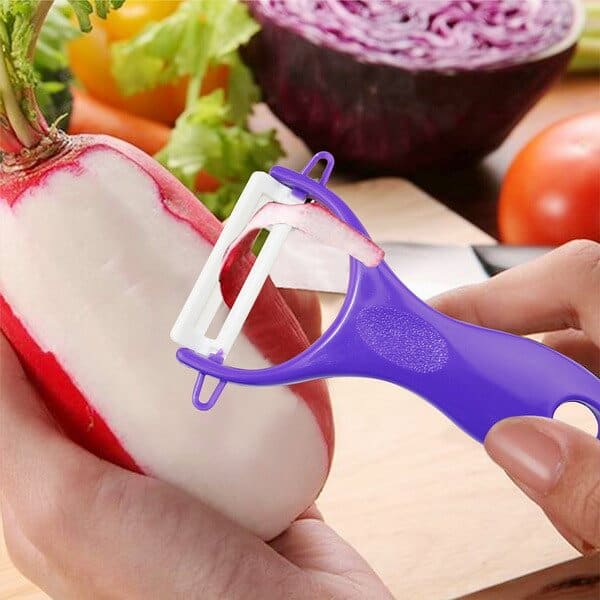
There are specific foods that should be cut using a ceramic knife. Most fruits and vegetables, as well as cold butter, can be easily and efficiently sliced by using a ceramic knife with no troubles.
The problem arises with foods that are harder and more difficult to chop up. Items like frozen goods, meat containing bones, or even fruits with seeds, should not be cut using a ceramic knife as this will dull out the knife and can lead to parts chipping or breaking.
Sharpening Ceramic Knives: The Problems You May Encounter
Despite the taught in this article, beginners may experience some difficulties in carrying out this procedure on their first few attempts. We are listing down these problems so that people can become aware of them, alongside the precautions to take in order to minimize them:
Using the Wrong Techniques
People who are new to sharpening ceramic knives are not familiar with the amount of pressure that should be applied while sharpening the blade. Due to this, they tend to exert unnecessary pressure on the blade, leading to parts of the blade chipping away or the blade itself snapping in half.
In order to avoid this problem, a proper handling technique needs to be applied when sharpening a ceramic blade on a diamond stone. The blade of the ceramic knife should be glided along with the stone as this will provide proper support to the blade without it being damaged.
Not Being Aware of How Much Sharpening is Enough
Generally, a lot of people cannot understand when to cease the sharpening process and over-sharpen their knives, which can cause a reduction in their lifespan and cutting ability.
Unlike conventional steel knives, it is difficult to tell when to stop sharpening ceramic knives as there is no clear indicator. Thus, it is advisable to under-sharpen your knife and then test its ability at different sharpness levels until you reach the optimum sharpness.
Be Informed About the Right Tools
The only type of material which can sharpen a ceramic knife is one that is stronger than it! Mostly the only materials which fit this criterion are the one which is diamond-encrusted.
Thus, you need to be well informed about the type of tools you use to sharpen your ceramic knife. Some tools, such as the ceramic sharpening rods, are not in a position to achieve this sharpness due to them being on the same strength level as ceramic knives rather than being stronger.
Final Thoughts
Ceramic knives are slowly becoming a staple in households across the world. And why wouldn’t they be? They are affordable, light, and come with a variety of features that make their users feel effective. Despite their few drawbacks, ceramic knives represent a unique option for cutting and slicing softer foods. With the right tools and techniques, these knives can last much longer than the more traditional stainless steel knives people are accustomed to!
But ceramic knives that are not sharp won’t help you accomplish your tasks. Of course, we all want our knives to be sharp. But over time, the knives become dull and require sharpening. But you don’t necessarily need to visit a professional to make your knives sharp. You can achieve almost the same results by doing it at home. With the methods discussed above, you can quickly make your ceramic kitchen knives sharp at home.

Gary Portman is the founder and main author of Knivesadvice.com. With his extensive knowledge and experience, he is committed to assisting people in choosing the perfect knife for their needs. Through his articles, Gary shares valuable insights on various aspects of knives. With his expertise, readers can make informed decisions and find a knife that is tailored to their preferences and requirements. You can find more info about Gary here.

